The Intel Core i9-9980XE CPU Review: Refresh Until it Hertz
by Ian Cutress on November 13, 2018 9:00 AM ESTGaming: Grand Theft Auto V
The highly anticipated iteration of the Grand Theft Auto franchise hit the shelves on April 14th 2015, with both AMD and NVIDIA in tow to help optimize the title. GTA doesn’t provide graphical presets, but opens up the options to users and extends the boundaries by pushing even the hardest systems to the limit using Rockstar’s Advanced Game Engine under DirectX 11. Whether the user is flying high in the mountains with long draw distances or dealing with assorted trash in the city, when cranked up to maximum it creates stunning visuals but hard work for both the CPU and the GPU.
For our test we have scripted a version of the in-game benchmark. The in-game benchmark consists of five scenarios: four short panning shots with varying lighting and weather effects, and a fifth action sequence that lasts around 90 seconds. We use only the final part of the benchmark, which combines a flight scene in a jet followed by an inner city drive-by through several intersections followed by ramming a tanker that explodes, causing other cars to explode as well. This is a mix of distance rendering followed by a detailed near-rendering action sequence, and the title thankfully spits out frame time data.
There are no presets for the graphics options on GTA, allowing the user to adjust options such as population density and distance scaling on sliders, but others such as texture/shadow/shader/water quality from Low to Very High. Other options include MSAA, soft shadows, post effects, shadow resolution and extended draw distance options. There is a handy option at the top which shows how much video memory the options are expected to consume, with obvious repercussions if a user requests more video memory than is present on the card (although there’s no obvious indication if you have a low end GPU with lots of GPU memory, like an R7 240 4GB).
| AnandTech CPU Gaming 2019 Game List | ||||||||
| Game | Genre | Release Date | API | IGP | Low | Med | High | |
| Grand Theft Auto V | Open World | Apr 2015 |
DX11 | 720p Low |
1080p High |
1440p Very High |
4K Ultra |
|
All of our benchmark results can also be found in our benchmark engine, Bench.
| Game | IGP | Low | Medium | High |
| Average FPS | 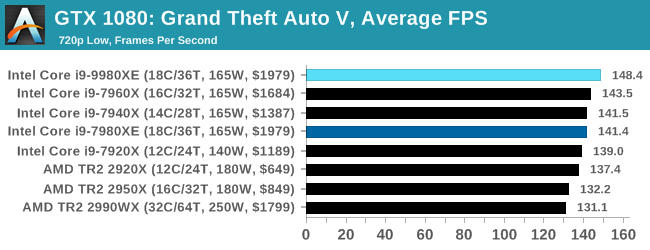 |
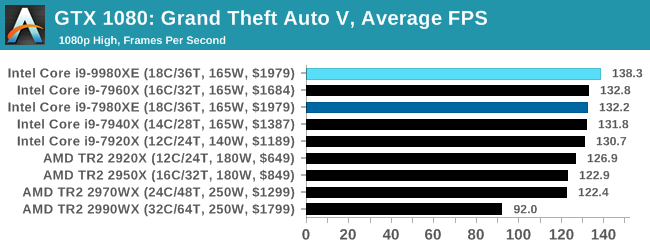 |
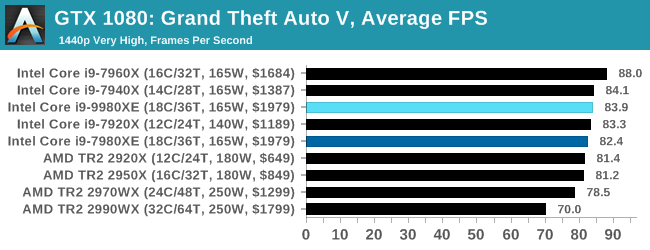 |
 |
| 95th Percentile | 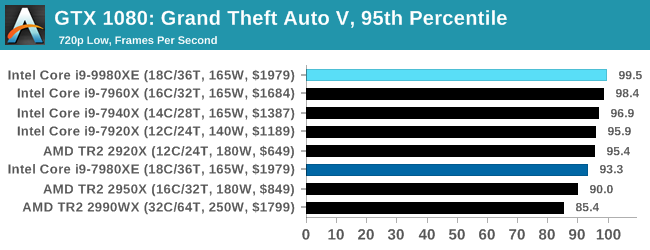 |
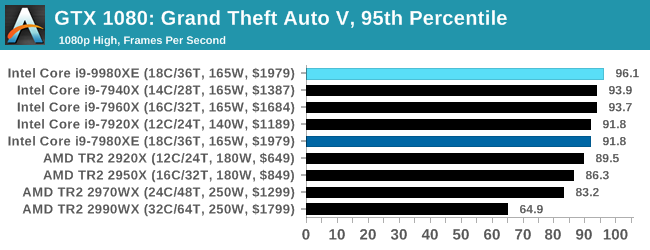 |
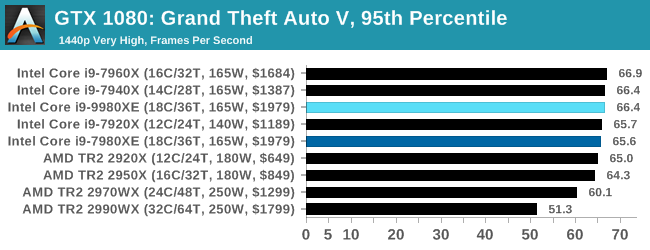 |
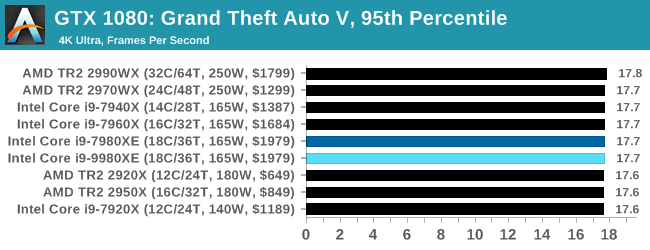 |












143 Comments
View All Comments
zeromus - Wednesday, November 14, 2018 - link
@linuxgeek, logged in for the first time in 10 years or more just to laugh with you for having cracked the case with your explanation there at the end!HStewart - Tuesday, November 13, 2018 - link
I have IBM Thinkpad 530 with NVidia Quadro - in software development unless into graphics you don't even need more than integrated - even more for average business person - unless you are serious into gaming or high end graphics you don't need highend GPU. Even gaming as long as you are not into latest games - lower end graphics will do.pandemonium - Wednesday, November 14, 2018 - link
"Even gaming as long as you are not into latest games - lower end graphics will do."This HEAVILY depends on your output resolution, as every single review for the last decade has clearly made evident.
Samus - Wednesday, November 14, 2018 - link
Don't call it an IBM Thinkpad. It's disgraceful to associate IBM with the bastardization Lenovo has done to their nameplate.imaheadcase - Tuesday, November 13, 2018 - link
Uhh yah but no one WILL do it on mobility. Makes no sense.TEAMSWITCHER - Tuesday, November 13, 2018 - link
You see .. there you are TOTALLY WRONG. Supporting the iPad is a MAJOR REQUIREMENT as specified by our customers.Augmented reality has HUGE IMPLICATIONS for our industry. Try as you may ... you can't hold up that 18 core desktop behemoth (RGB lighting does not defy gravity) to see how that new Pottery Barn sofa will look in your family room. I think what you are suffering from is a historical perspective on computing which the ACTUAL WORLD has moved away from.
scienceomatica - Tuesday, November 13, 2018 - link
@TEAMSWITCHER - I think your comments are an unbalanced result between fantasy and ideals. I think you're pretty superficially, even childishly looking at the use of technology and communicating with the objective world. Of course, a certain aspect of things can be done on a mobile device, but by its very essence it is just a mobile device, therefore, as a casual, temporary solution. It will never be able to match the raw power of "static" desktop computers.working in a laboratory for physical analysis, numerous simulations of supersymmetric breakdowns of material identities, or transposition of spatial-temporal continuum, it would be ridiculous to imagine doing on a mobile device.There are many things I would not even mention.HStewart - Tuesday, November 13, 2018 - link
For videos - as long as you AVX 2 (256bit) you are ok.SanX - Wednesday, November 14, 2018 - link
AMD needs to beat Intel with AVX to be considered seriously for scientific apps (3D particle movement test)PeachNCream - Tuesday, November 13, 2018 - link
All seven of our local development teams have long since switched from desktops to laptops. That conversion was a done deal back in the days of Windows Vista and Dell Latitude D630s and 830s. Now we live in a BYOD (bring your own device) world where the company will pay up to a certain amount (varies between $1,100 and $1,400 depending on funding from upper echelons of the corporation) and employees are free to purchase the computer hardware they want for their work. There are no desktop PCs currently and in the past four years, only one person purchased a desktop in the form of a NUC. The reality is that desktop computers are for the most part a thing of the past with a few instances remaining on the desks of home users that play video games on custom-built boxes as the primary remaining market segment. Why else would Intel swing overclocking as a feature of a HEDT chip if there was a valid business market for these things?